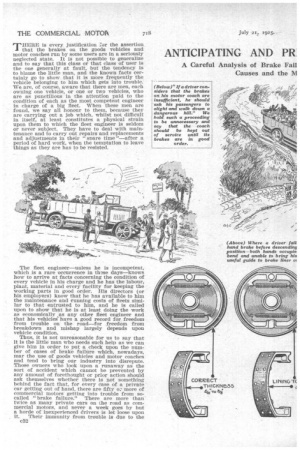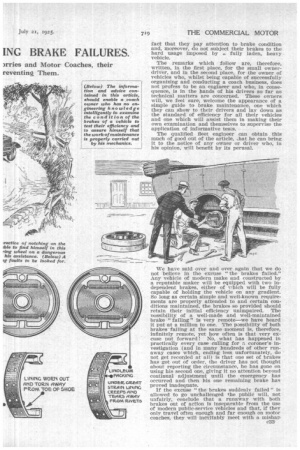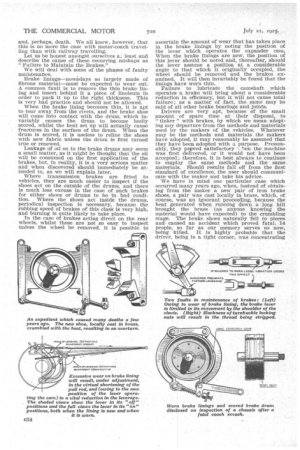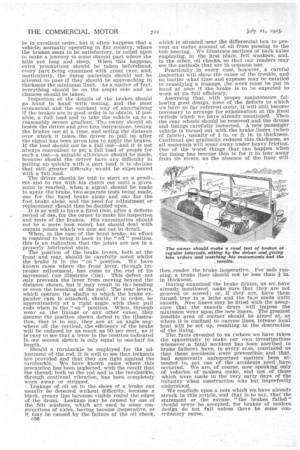ANTICIPATING AND PR ING BRAKE FAILURES.
Page 16

Page 17

Page 18

Page 19

Page 20

If you've noticed an error in this article please click here to report it so we can fix it.
'THERE is every justification for the assertion -I that the brakes on the goods vehicles and motor coaches run by some users are in a seriously neglected state. It is not possible to generalize and to say that this class or that class of user is the one generally at fault, but the tendency is to blame the little man, and the known facts certainly go to show that it is more frequently the vehicle belonging to him which gets into trouble. We are, of course, aware that there are men, each owning one vehicle, or one or two vehicles, who are as punctilious in the attention paid to the condition of each as the most competent engineer in charge of a big fleet. When these men are found, we say all honour to them, because they are carrying out a job which, whilst not difficult in itself, at least constitutes a physical strain upon them to which the fleet engineer is seldom or never subject. They have to deal with maintenance and to carry out repairs and replacements and adjustments in their " spare time "—after a period of hard work, when the temptation to leave things as they are has to be resisted.
The fleet engineer—unless he is incompetent, which is a rare occurrence in these days—knows bow to arrive at facts concerning the condition of every vehicle in his charge and he has the labour, plant, material and every facility for keeping the• working parts in good order. His directors (or his employers) know that he has available to him the maintenance and ,running costs of fleets similar to that entrusted to him, and he is called upon to show that he is at least doing the work as economically as any other fleet engineer and that his vehicleshave a good record for freedom from trouble on the road—for freedom from breakdown and mishap largely depends upon vehicle condition.
Thus, it is not unreasonable for us to say that it is the little man who needs such help as we can give him in order to put a check upon the number of cases of brake failure which, nowadays, mar the use of goods vehicles and motor coaches and tend to bring our industry Into disrepute. Those owners who look upon a runaway as the sort of accident which cannot be prevented by any amount of forethought or prior action should ask themselves whether there is not something behind the fact that, for every case of a private car getting out of hand, there are fifty oz more of commercial motors getting into trouble from socalled " brake failure." There are more than twice as many private cars on the road as commercial motors, and never a week goes by but a horde of inexperienced drivers is let loose upon it. Their immunity from trouble is due to the
c32 fact that they pay attention to brake condition and, moreover, do not subject their brakes to the hard usage imposed by fully laden, heavy vehicle.
The remarks which follow are, therefore, written, in the first place, for the small ownerdriver, and in the second place, for the owner of vehicles who, whilst being capable of successfully organizing and. conducting a coach business, does not profess to be an engineer and who, in consequence, is in the hands of his drivers so far as technical matters are concerned. These owners will, we feel sure, welcome the appearance of a simple guide to brake maintenance, one which they can show to their drivers and lay down as the standard of efficiency for all their vehicles and one which will assist them in making their own examination and themselves to supervise the application of informative tests.
The qualified fleet engineer can obtain this much of good out of the article, that he can bring it to the notice of any owner or driver who, in his opinion, will benefit by its perusal.
We have said over and over again that we do not believe in the excuse "the brakes failed." Any vehicle of modern make and. constructed by a reputable maker will be equipped with two independent brakes, either of which will be fully capable of holding the vehicle on any gradient. So long as certain simple and well-known requirements are properly attended to and certain conditions maintained, the brakes so provided should retain their initial efficiency unimpaired. The possibility of a well-made and well-maintained brake " failing " is very remote—we have heard it put at a million to one. The possibility of both brakes-failing at the same moment is, therefore, infinitely remote, yet how often is that very excuse put forward! No, what has happened in practically every case calling for t-t coroner's investigation (and in many hundreds of other runaway eases which, ending less unfortunately, do not get recorded at all) is that one set of brakes has got out of order, the driver has not thought about reporting the circumstance, he has gone on using his second one, giving it no attention beyond continual adjustment until the emergency has occurred and then his one remaining brake has proved inadequate.
If the excuse "the brakes suddenly failed." is allowed to go unchallenged the public will, not unfairly, conclude that a runaway with both brakes out of action is inseparable from the use of modern public-service vehicles and that, if they only travel often enough and far enough on motor coaches, they will Inevitably meet with a mishap and, perhaps, death. We all know, however, that this is no more the case with motor-coach travelling than with railway travelling.
Let us be honest amongst ourselves a, least and describe the cause of these recurring mishaps as "Failure to Maintain the Brakes."
We will deal with some of the phases of faulty maintenance.
Brake linings—nowadays so largely made of fibrous material—must be expected to wear out. A common fault is to remove the thin brake lining and insert behind it a piece of linoleum in order to pack it up to the right thickness. This is very bad practice and should not be allowed.
When the brake lining becomes thin, it is apt to tear away from the rivets, and the brake shoe will come into contact with the drum, which invariably causes the drum to become badly scored, whilst the heat set up will actually cause fractures in the surface of the drum. When the drum is scored, it is useless to reline the shoes with new fabric unless the drum is first turned true or renewed.
Leakage of oil on to the brake drums may seem a small matter, as it might be thought that the oil will be consumed on the first application of the brakes, but, in reality, it is a very serious matter and when discovered should immediately be attended to, as we will explain later. Where transmission brakes are fitted to vehicles, they are much easier to inspect if the shoes act on the outside of the drums, and there Is much less excuse in the case of such brakes for either shoes or drums to be in bad condition. Where the shoes act inside the drums, periodical inspection is necessary, because the rubbing speed of brakes of this class is very high, and burning is quite likely to take place. In the case of brakes acting direct on the rear wheels, whilst these are not so easy to inspect unless the wheel be removed, it is possible to ascertain the amount of wear that has taken place in the brake linings by noting the position of the lever which operates the expander cam, When the brake linings are new, the position of this lever should be noted and, thereafter, should the lever assume a position at a considerable angle to that which it originally occupied, the wheel should be removed and the brakes examined. It will then invariably be found that the linings have worn thin.
Failure to lubricate the camshaft which operates a brake will bring about a considerable reduction in efficiency, but it will not cause total failure ; as a matter of fact, the same may be said of all other brake bearings and joints.
Drivers are very apt, because of the small amount of spare time at their disposal, to " tinker " with brakes, by which we mean adopting any departure from the methods and materials used by the makers of the vehicles. Whatever may be the methods and materials the makers have adopted, it may reasonably be assumed that they have been adopted with a purpose. Presumably, they preyed satisfactory -\ -hen the machine was first delivered, or it would not have been accepted ; therefore, it is best always to continue to employ the same methods and the same materials. Should results fall off from the first standard of excellence, the user should communicate with the maker and take his advice.
We have in mind one particular case which occurred many years ago, when, instead of obtaining from. the maker a new pair of iron brake shoes, a pair was cast locally in brass, which, of course, was an ignorant proceeding, because the heat generated when running down a long hill brought the brass (as anyone knowing the material would have expected) to the crumbling stage. The brake shoes naturally fell to pieces andcaused an accident which proved fatal, 14 people, so far as our memory serves us now, being killed. It is highly probable that the driver, being in a tight corner, was concentrating the strength of his arms on the steering and did not use the side brake—or it may be that he himself knew that that brake was already out of order and had been relying solely upon the foot brake.
This rather brings us to the point that owners should mate quite sure that their drivers are not addicted to the one-brake habit. We have often heard drivers make the remark --hat they "never trouble about their hand brake, their foot brake being all right." This sometimes arises from the fact that the driver has to reach long way out in order to get hold of the brake lever, and, of course, to the obvious fact that the slower running speed of the hand brake gives the impression that it is not so efficient as the foot brake. As a matter of fact, this slower running speed makes the hand brake much more suitable for long hills, and the owner of% vehicle will be doing good work
by schooling his drivers into notching up the hand brake at the commencement cf a dangerous hill, so that should anything by chance happen to the foot brake the vehicle is not from that moment entirely out of control.
A driver should also be aught the plan of going into a low gear and of using the engine as a brake, although, of course, this, whilst being an extremely good practice and perfectly sound, should never be allowed to encourage the neglect of the brakes proper. Again, it entails the exercise of common sense in the matter of engaging a low speed, as it is useless for a driver, when the vehicle has already gained considerable way, to disengage top gear, with the intention of engaging a lower one, as, of course, that becomes virtually an impossible thing to do. As a matter of fact, very few drivers realize the wonderful braking Power there is in the majority of engines when they are throttled down to the minimum and particularly when the lowest gear is engaged. Another good point about using the engine as a brake is that it undoubtedly saves wear on the brake linings. To deal now with inspection and testing of brakes, we hold that whatever may be the nature of the country in which the vehicle is operating, whether flat or hilly, the brakes should always be in excellent order, but it often happens that a vehicle, normally operating in flat country, where the brakes seem to be satisfactory, is called upon to make a journey to some distant part where the hills are long and steep. When this happens, extra precautions should be taken beforehand, every part being examined with great care, and, particularly, the lining materials should not be allowed to pass if they should be approaching in thickness the minimum limit. As a matter of fact, everything should be on the ample side and no chances should be taken.
Inspection of the details of the brakes should go hand in hand with testing, and the most economical and the quickest way of ascertaining if the brakes are in good order is to obtain, if possible, a full load and to take the vehicle on to a reasonably severe gradient. Tho owner should sit beside the driver and give him instructions, testing the brakes one at a time, and noting the distance over which it takes the driver to pull up after the signal has been given him to apply the brakes. If the load should not be a full one—and it is not always convenient to get a full load of people for such a test—a suitable allowance should be made, because should the driver have any difficulty in pulling up quickly with a part load, it is obvious that still greater difficulty wculd be experienced with a full load.
The driver should be told to start on a gradient and to run with his clutch out until a given point is reached, when a signal should be made to apply the brake, two separate tests being made, one for the hand brake alone and on for the foot brake alone, and the need for adjustment or replacement should then be decided upon.
It is as well to have a fixed time, after a definite Period of use, for the owner to make his inspection and tests of the brakes. His examination should not be a mere look round, but should deal with certain points which we now set out in detail.
When, in the case of the hand brake, an effort Is required to bring it back to the " off " position, this is an indication that the joints are not in a properly lubricated state.
The position of the brake levers, both at the front and rear, should be carefully noted whilst the brake is in the " on " position. We have known cases where the front lever, through improper adjustment, has come to the end of its movement (we illustrate t'ais). This defect not only prevents the lever from moving beyond the distance shown, but it may result in tin bending or even the breaking of the rod. The rear levers, which operate the shafts to which the brake expander cam is attached, should, if in order, be approximately at a right angle with their pull rods when in the " on " position. When, through wear on the linings or any other cause, they assume the position shown dotted in the illustration, that is to say, they are at an angle anywhere off the vertical, the efficiency of the brake will be reduced by as much as 50 per cent., as it Is easy to see that a lever in the position indicated In our second sketch is only equal to one-half its length.
Should a turnbuckle be employed for the adjustment of the rod, it is well tosee that locknuts are provided and that they are tight against the turnbuckle.have known cases where this precaution as been neglected, with the result that the thread, both on the rod and in the turnbuckle, through continual vibration, has been completelyworn away or stripped.
Leakage of oil on to the shoes of a brake can usually be detected without difficulty, because a black, greasy line becomes visible round the edges of the drum. Leakage may be caused by one of the felt washers, which are used in some constructions of axles, having become inoperative, or it may be caused by the failure of the oil check, c36 which is situated near the differential box to prevent an undue amount of oil from passing to the hub bearing. We illustrate sections of bad: axles employing, in the first place, felt washers, and, in the other, oil checks, so that our readers may see the methods that are in common use.
Practically in every case, however, a careful inspection will show the cause of the trouble, and no matter what time and expense may be entailed in remedying a leakage, the work must be put in hand at once if the brake is to be expected to work at its full efficiency.
Assuming that, with proper maintenance following good design, none of the defects to which we have so far referred occur, it will still become necessary to arrange for examination at the fixed periods which we have already mentioned. Then the rear wheels should be removed and the drums and linings carefully insnected. A new passenger vehicle is turned out with the brake liners (when of fabric), usually of in. or * in. in thickness. Continual use gradually reduces this thickness, as all materials will wear away under heavy friction. One of the worst things that can happen when the lining has become thin Is for it to tear away from its rivets, as the absence of the liner will then render the brake inoperative. For safe running, a brake liner should not be less than in. in thickness.
Having examined the brake drums, as we have already mentioned, make sure that they are not grooved or scored ; or, if they are, have them turned true in a lathe and the face made quite smooth. New liners may be fitted with the assur ance that the smooth drum will impose the minimum wear upon the new liners. The greatest possible area of contact should be aimed at, as where it is confined to narrow lines, intense local heat will be set Up, resulting in the destruction of the lining.
The facts revealed to us (where we have taken the opportunity to make our own investigations whenever , a fatal accident has been ascribed to
brake failure) have, in every case, convinced us that these accidents were preventible and that,
had apparently unimportant matters been at tended to, not one of the accidents need have occurred. We are, of course, now speaking only of vehicles of modern make, and not of those which were made in the very early days of the industry when construction was but imperfectly understood.
We conclude upon a note which we have already struck in this article. and that is to say, that the statement or the excuse "the brakes failed" should never be accepted, for brakes of modern design do not fall unless the/ e be some contributory cause.
































